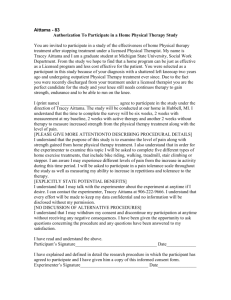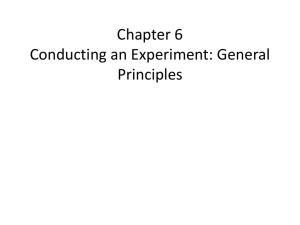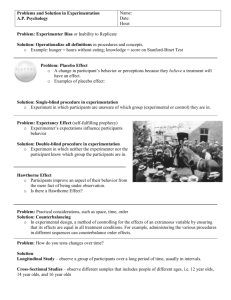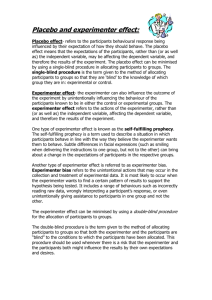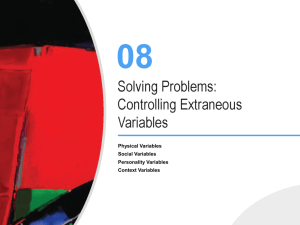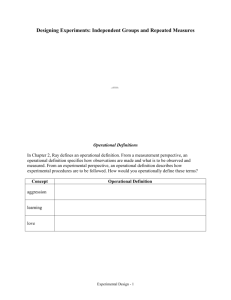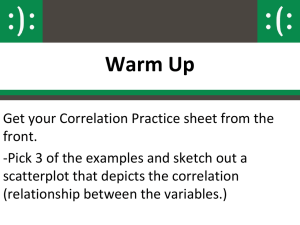Lecture 7 - Dr. Jennifer Vonk
advertisement
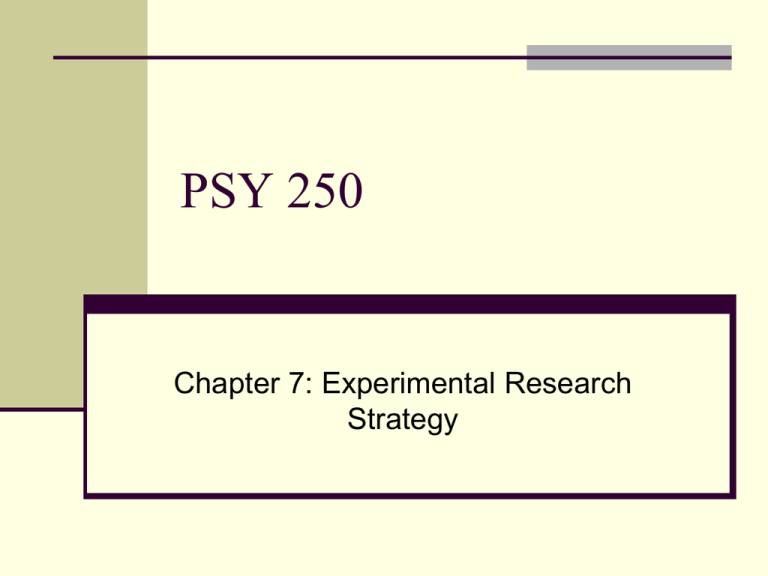
PSY 250 Chapter 7: Experimental Research Strategy Cause and Effect Relationships Can be clear relationship but not a causal one – e.g. between getting dressed up and having a headache the next morning 4 basic elements to establish cause and effect: 1. 2. 3. 4. Manipulation Measurement Comparison Control Variables Independent Dependent Extraneous Levels of the IV The different values of the IV selected to create and define the treatment conditions Must be ≥ 2 Treatment Condition Situation or environment characterized by one specific value of the IV The Third-Variable Problem Can be clear relationship but not a direct causal one between 2 variables E.g. children’s involvement in extra-curricular abilities and confidence 3rd variable may be controlling both of the other 2 (family involvement, opportunities for more friendships) Research becomes the art of teasing apart and separating a set of naturally interconnected variables Control Eliminate all confounding variables E.g. Meaningfulness and imagery (Paivio, 1965) Create two lists (high vs. low imagery) with equal average meaningfulness Classification of confounding vs. independent variable depends on research hypothesis The Directionality Problem Which is the cause and which is the effect E.g. assertiveness and success Sleep and depression Manipulation and Control Unique to experimental research strategy Manipulation Create treatment conditions corresponding to values of IV If change in A does not cause change in B then A is not a causal agent (unless change is too small to affect B) Control Prevent extraneous variables from becoming confounding variables Only confounding if it influences DV AND It varies systematically with IV 3 types of extraneous variables: Environmental Participant Time - Related Methods of Controlling Extraneous Variables 1. Holding a Variable Constant Hold absolutely constant or Limit to restricted range But can limit generalizability What is this a threat to? Methods of Controlling Extraneous Variables 2. Matching Values across Treatment Conditions E.g. each condition has = males and females Or ensure average value is same – e.g. average age is 4.5 in each group Also match on environmental and time variables 3. Matching by Yoked Control Controls for possible influence of temporal relationship between event and response Ulcers due to physical or psychological stress of shock in monkeys (Brady, 1958) 4. Building Extraneous Variable into the Design Sample of participants with IQs of 90 - 119 Subsamples with specified IQ values Participants with 90-99 IQ identified Participants with 100-109 IQ IQ values built into design 90 - 99 100 -109 110 -119 Learning strategy A B Participants with 110-119 IQ 5. Matching by Equating Participants Also increases sensitivity of exp. Similar to building EV into design # of participants is some multiple of the # of levels of the IV Two methods 5a. Precision Control Sample of research participants Each participant measured in terms of age, gender, IQ, etc Each participant matched with 2nd participant of same age, gender, IQ, etc. Each pair of matched participants Provides many matched randomly assigned to the treatment conditions Treatment A Treatment B pairs of participants 5b. Frequency Distribution Control 100 1st sample of Mean = 107 participants S.D. = 5.4 80 60 40 Similar frequency 20 distribution of 0 IQ scores 100 80 60 40 20 0 2nd sample of participants Mean = 106.5 S.D. = 5.1 Methods of Controlling Extraneous Variables 6. Randomization Disrupts any systematic relation between EVs and IV – prevents EVs from becoming CVs Unpredictable, unbiased procedure to distribute different values of each EV across treatment conditions All possible outcomes equally likely But chance CAN produce biased outcomes – e.g. all heads with 10 coin tosses Control Through Participant Assignment Random assignment ensures influential extraneous variables are balanced among experimental conditions “whenever possible, randomize” representative Free random assignment random numbers Counterbalancing To control for sequencing effects Order effects IV – rate of presentation of nonsense syllables DV – verbal learning Learn slow, moderate then fast list – speed confounded with order Carry-over effects Performance in condition partially dependent on preceding conditions IV – monetary reward Dime may be more rewarding when preceded by 5 vs. 15 cents Control Groups No treatment condition Provides baseline measure of normal behavior Experimental group – treatment condition Placebo control groups General Control Procedures Preparation of setting structuring research setting Response measurement careful selection and preparation of measures Replication systematic and conceptual replication Control Over Subject and Experimenter Effects Experimenter effects Participant (subject) effects demand characteristics Control Over Subject and Experimenter Effects (cont’d) Single-blind procedures experimenter is unaware Partial-blind Experimenter unaware for portions of exp. Double-blind procedures experimenter and participant are unaware Deception Participant is unaware Control Over Experimenter Effects (cont’d) Automation reduces experimenter-participant contact Using objective measures require minimal judgements Control Over Subject and Experimenter Effects (cont’d) Multiple observers ratings of behaviors Control of experimenter attribute errors physical and psychological characteristics Hold constant across treatments Gaining Insight Into Participants’ Perceptions of Experiment Experimental manipulation check Did manipulation work? What did participant think experiment was about? How does participant think others will respond? Participant Manipulations Subtle Manipulations Simulations Placebo Controls Simulation Studies Try to duplicate natural environment in lab – bring real world into lab Mundane Realism Superficial, physical characteristics Experimental Realism Psychological aspects of situation Do participants become immersed in situation E.g. Haney, Banks & Zimbardo (1973) prisoner study Prisoner’s dilemma Field Studies Bring lab into real world E.g. Bystander Apathy in emergency situations


